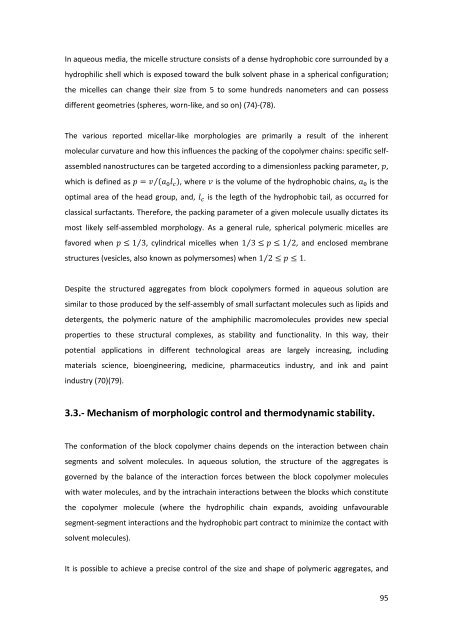Self-Assembly of Synthetic and Biological Polymeric Systems of ...
Self-Assembly of Synthetic and Biological Polymeric Systems of ...
Self-Assembly of Synthetic and Biological Polymeric Systems of ...
You also want an ePaper? Increase the reach of your titles
YUMPU automatically turns print PDFs into web optimized ePapers that Google loves.
In aqueous media, the micelle structure consists <strong>of</strong> a dense hydrophobic core surrounded by a<br />
hydrophilic shell which is exposed toward the bulk solvent phase in a spherical configuration;<br />
the micelles can change their size from 5 to some hundreds nanometers <strong>and</strong> can possess<br />
different geometries (spheres, worn-like, <strong>and</strong> so on) (74)-(78).<br />
The various reported micellar-like morphologies are primarily a result <strong>of</strong> the inherent<br />
molecular curvature <strong>and</strong> how this influences the packing <strong>of</strong> the copolymer chains: specific self-<br />
assembled nanostructures can be targeted according to a dimensionless packing parameter, ,<br />
which is defined as<br />
, where is the volume <strong>of</strong> the hydrophobic chains, is the<br />
optimal area <strong>of</strong> the head group, <strong>and</strong>, is the legth <strong>of</strong> the hydrophobic tail, as occurred for<br />
classical surfactants. Therefore, the packing parameter <strong>of</strong> a given molecule usually dictates its<br />
most likely self-assembled morphology. As a general rule, spherical polymeric micelles are<br />
favored when<br />
, cylindrical micelles when<br />
structures (vesicles, also known as polymersomes) when<br />
, <strong>and</strong> enclosed membrane<br />
Despite the structured aggregates from block copolymers formed in aqueous solution are<br />
similar to those produced by the self-assembly <strong>of</strong> small surfactant molecules such as lipids <strong>and</strong><br />
detergents, the polymeric nature <strong>of</strong> the amphiphilic macromolecules provides new special<br />
properties to these structural complexes, as stability <strong>and</strong> functionality. In this way, their<br />
potential applications in different technological areas are largely increasing, including<br />
materials science, bioengineering, medicine, pharmaceutics industry, <strong>and</strong> ink <strong>and</strong> paint<br />
industry (70)(79).<br />
3.3.- Mechanism <strong>of</strong> morphologic control <strong>and</strong> thermodynamic stability.<br />
The conformation <strong>of</strong> the block copolymer chains depends on the interaction between chain<br />
segments <strong>and</strong> solvent molecules. In aqueous solution, the structure <strong>of</strong> the aggregates is<br />
governed by the balance <strong>of</strong> the interaction forces between the block copolymer molecules<br />
with water molecules, <strong>and</strong> by the intrachain interactions between the blocks which constitute<br />
the copolymer molecule (where the hydrophilic chain exp<strong>and</strong>s, avoiding unfavourable<br />
segment-segment interactions <strong>and</strong> the hydrophobic part contract to minimize the contact with<br />
solvent molecules).<br />
It is possible to achieve a precise control <strong>of</strong> the size <strong>and</strong> shape <strong>of</strong> polymeric aggregates, <strong>and</strong><br />
.<br />
95

















